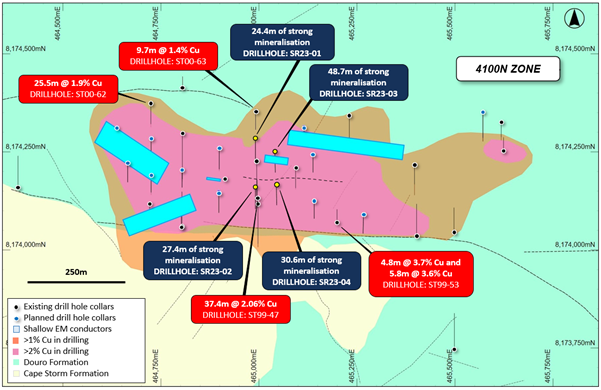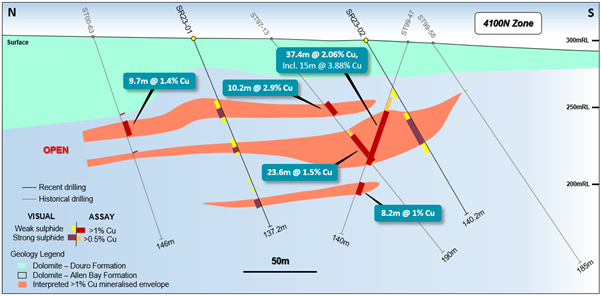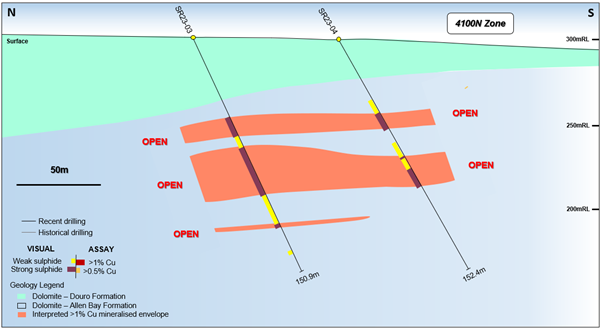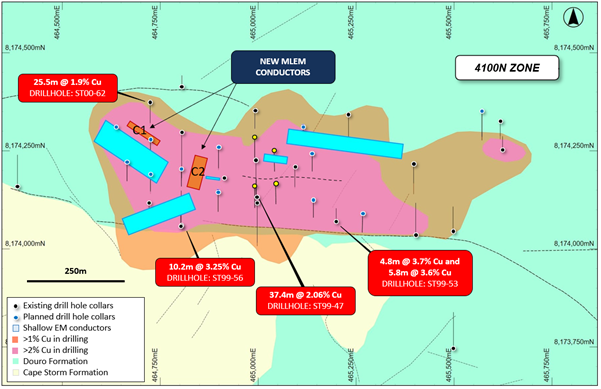Chalcocite !!! all Holes I view this as very important seeing Chalcocite ( CC ) on surface and at depth.
The Chalcocite Copper ORE is very high grade and shows no impurities. The copper ore is condusive to a Mill Flotation process..
DRILL HOLE DETAILS
Drill holes SR23-01, SR23-02, SR23-03 and SR23-04 have intersected thick intervals of copper sulfide mineralization, hosted within dolomite of the Allen Bay Formation.
The mineralization encountered within the drilling to date comprises zones of strong sulfides hosted within a broad mineralized package of what is interpreted to be mostly vein and fracture-style mineralization. The mineralized horizons are interpreted to be relatively flat-lying and hosted within a porous, laterally extensive carbonate layer.
The dominant copper sulfide mineral observed within the drill holes to date is chalcocite, with minor bornite and chalcopyrite on the margins of the mineralized intervals and within veins. Minor native copper and copper oxides (mostly malachite and cuprite) are also present.
Chalcocite is an important ore mineral due to its high copper content (79.8% copper) and outstanding metallurgical properties.
The Allen Bay host unit is present throughout the Storm Project area and is composed of massive to thinly bedded dolomicrites.
| Hole ID | Prospect | Easting | Northing | Depth (m) | Azi | Inclination | Type |
| SR23-01 | 4100N | 464991 | 8174285 | 137.2 | 180 | -65 | RC |
| SR23-02 | 4100N | 464990 | 8174157 | 140.2 | 180 | -59 | RC |
| SR23-03 | 4100N | 465041 | 8174251 | 151 | 178 | -65 | RC |
| SR23-04 | 4100N | 465045 | 8174166 | 152.4 | 179 | -69 | RC |
Table 1: 2023 program drill hole details. Note - depth in metres has been converted from measurements in feet and is rounded.
Intersections are expressed as downhole widths and are interpreted to be close to true widths. Visual estimates of sulfide type, quantity and habit should not be considered a substitute for laboratory assays. Portable XRF analysis has been used to confirm the nature of the sulfide intercepts. Laboratory assays are required to determine the widths and grade of mineralization as reported in preliminary geological logging.


Mineralization key: cc = chalcocite, chpy = chalcopyrite, br = bornite, py = pyrite, Cu = native copper, ct = cuprite, ml = malachite, sph = sphalerite, ga = galena. (5%) = visual estimation of sulfide content.
| Hole ID | From (m) | To (m) | Min | Description |
| SR23-01 | 0.0 | 21.3 | | Cape Storm Formation |
| | 21.3 | 48.8 | | Allen Bay Formation |
| | 48.8 | 54.9 | ml, cpy, cc | veinlets of ml with cpy selvage and trace cc, (1%) |
| | 54.9 | 59.4 | cc, ml, ct | cc veinlets with ct and trace ml (2.5%) |
| | 59.4 | 64.0 | ml, ct | trace ml veinlets with ct selvage |
| | 64.0 | 80.8 | py | Allen Bay Formation |
| | 80.8 | 86.9 | cc, py | cc veinlets and trace blebby py (1.5%) |
| | 86.9 | 99.1 | ml, py, ct | trace ml veinlets with patchy ct and trace blebby py with chert (<1%) |
| | 99.1 | 106.7 | Cu, cc, py, ct | native Cu and py in vein selvage with cc and ct (4%) |
| | 106.7 | 114.3 | | Massive to weakly bedded dolomudstone with minor cherty bands |
| | 114.3 | 117.3 | py, cc | dense py veinlets with cc and selvage ct (2.5%) |
| | 117.3 | 121.9 | Cu, py | dense py veins with abundant fine native Cu stringers and selvage (5%) |
| | 121.9 | 125.0 | ml, py, ct | ml veinlets with ct selvage and blebby py (<1%) |
| | 125.0 | 126.5 | cc, ml, ct | cc veinlets with ml selvage and trace ct (1%) |
| | 126.5 | 137.2 | | Allen Bay Formation |
Table 2: Summary geological log for drill hole SR23-01.
| Hole ID | From (m) | To (m) | Min | Description |
| SR23-02 | 0.0 | 24.4 | ml | Cape Storm Formation |
| | 24.4 | 39.6 | ml | Allen Bay Formation |
| | 39.6 | 47.2 | ml, py, cc | trace cc veinlets with py and ml selvage (1%) |
| | 47.2 | 53.3 | py | py in recrystalized dolomudstone (1%) |
| | 53.3 | 56.4 | ml, ct | trace ml and ct in fractures at top of interval |
| | 56.4 | 68.6 | Cu, cc, py, cpy | cc veinlets with selvage Cu, trace cpy (1.5%) |
| | 68.6 | 76.2 | py, cc | dense cc veinlets and patchy py (1.5%) |
| | 76.2 | 83.8 | cc, Cu, py | cc veinlets with Cu in selvage and patcy py (2%) |
| | 83.8 | 88.4 | cc, py, ml | trace cc veinlets with py and ml selvage (<1%) |
| | 88.4 | 91.4 | Cu, cc, ml | patchy cc and Cu, trace ml veinlets (<1%) |
| | 91.4 | 108.2 | py, ml | trace patchy py and ml (<1%) |
| | 108.2 | 111.3 | cc, ml | cc veinlets and selvage ml at bottom of unit |
| | 111.3 | 140.2 | py | Allen Bay Formation |
Table 3: Summary geological log for drill hole SR23-02.
| Hole ID | From (m) | To (m) | Min | Description |
| SR23-03 | 0.0 | 39.6 | | Cape Storm Formation |
| | 39.6 | 54.9 | cc, py, chpy | cc veinlets with selvage chpy and py (0.5%) |
| | 54.9 | 68.6 | cc, chpy, sph, py | abundant cc veinlets with selvage chpy, sph and py (2%) |
| | 68.6 | 73.2 | cc, chpy, py | trace cc veinlets with selvage chpy and py (0.5%) |
| | 73.2 | 83.8 | cc, br, chpy, py, sph | abundant cc and chpy veinlets with patchy br, sph, Cu veinlets and py (1.5%) |
| | 83.8 | 100.6 | cc, br, chpy, py, sph | abundant cc and chpy veinlets with patchy br, sph, Cu veinlets and py (1.5%) |
| | 100.6 | 106.7 | cc, chpy | cc veinlets and patchy chpy (0.5%) |
| | 106.7 | 109.7 | chpy, ga | chpy veinlets and trace ga (1%) |
| | 109.7 | 114.3 | chpy, py | trace chpy veinlets with minor py (0.5%) |
| | 114.3 | 121.9 | chpy, py | dense chpy veins and patchy py (2%) |
| | 121.9 | 137.2 | cpy, cc, py | cc and chpy veinlets and minor py (0.5%) |
| | 137.2 | 140.2 | cc, cpy | abundant cc veinls with patchy chpy (1%) |
| | 140.2 | 150.9 | cpy | Allen Bay Formation |
Table 4: Summary geological log for drill hole SR23-03.
| Hole ID | From (m) | To (m) | Min | Description |
| SR23-04 | 0.0 | 27.4 | | Cape Storm Formation |
| | 27.4 | 41.1 | | Allen Bay Formation |
| | 41.1 | 47.2 | chpy, py, ml | ml veinlets with selvage py and chpy (0.5%) |
| | 47.2 | 50.3 | chpy, ml, cc | cc veinlets with selvage chpy and ml (0.5%) |
| | 50.3 | 51.8 | ml, chpy | abundant ml veinlets with patchy chpy (0.2%) |
| | 51.8 | 61.0 | cc, ml, ct, py, chpy | cc and py veinlets with patchy selvage ml, ct and chpy (0.5%) |
| | 61.0 | 70.1 | py | trace py veinlets (0.2%) |
| | 70.1 | 79.2 | ml, ct, py | ml veinlets with patchy selvage py and ct (0.2%) |
| | 79.2 | 82.3 | cc, ml, ct | cc veinlets with selvage ct and ml (0.5%) |
| | 82.3 | 83.8 | ct, Cu, py | ct veinlets with patchy Cu and trace py (0.2%) |
| | 83.8 | 100.6 | Cu, cc, py | cc veinlets with Cu and patchy py (1%) |
| | 100.6 | 102.1 | py | trace py veinlets (0.2%) |
| | 102.1 | 115.8 | ml, cc | cc veinlets with patchy ml (0.5%) |
| | 115.8 | 137.2 | ml | trace patchy ml (0%) |
| | 137.2 | 152.4 | | Allen Bay Formation |
Table 5: Summary geological log for drill hole SR23-04.

MOVING LOOP ELECTROMAGNETICS (MLEM)
Moving loop electromagnetics (MLEM) is underway in parallel with the drilling to follow up on 11 shallow, high-priority EM conductors that were identified by the fixed loop electromagnetic (FLEM) survey completed by the Company during the 2021 field season.
Four out of a total of fifteen survey lines have been completed to date within the western part of the 4100N Zone.
Two strong, untested MLEM conductors have been identified, and both conductors are located close to historical copper intersections (including 25.5m (core length) @ 1.9% Cu from 78.8m in ST00-62).
Conductor 1 has been modeled as 30m x 100m, 65-degree northerly dip, 70-80m deep, and with a conductance of 600-900 Siemens (s). Conductor 2 is 75m x 25m with a shallow south dip, at approximately 60-70m depth, and with a conductance of 600-900s.
These new EM data outline zones of potentially more massive copper sulfide mineralization within the 4100N Zone. Historical conductors that have been tested with drilling are known to be associated with high-grade copper sulfides.
The planned drilling will be refined to test these new conductors as part of the resource definition drilling. MLEM surveys will also be completed at the 2750N and 2200N Zones.

PLANNED PROGRAM
Drilling at the 4100N Zone will be followed by resource definition at the 2200N and 2750N Zone, where drilling during 2023 intersected high-grade copper sulfides close to surface including 41m (core length) @ 4.18% Cu from 38M (ST22-05) downhole.
The first batch of samples has been sent to the laboratory, with results expected within two months.
Once the resource definition programs are complete, new areas for exploration will include the Blizzard, Tornado and Tempest Prospects. The Tempest Prospect is located approximately 40 kilometres south of the Storm deposits, and it contains a large (>250m long) copper gossan exposed at surface with assays up to 32% Cu. Its location and distance from Storm highlight the extensive nature of the prospective copper mineralization within the Project area.
Diamond drilling will be used to test the high-priority exploration targets and is expected to commence after the completion of the resource drilling.
Sorting and beneficiation test work for a potential direct shipping product (DSP) operation is continuing with results to follow shortly.